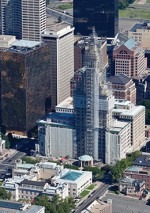December 2014
Scaffolding
Planning for Success
Engineering and communicationovercome challenges on Travelers Tower renovation as Safway Services erects the tallest, continuous Systems Scaffold structure in the United States.
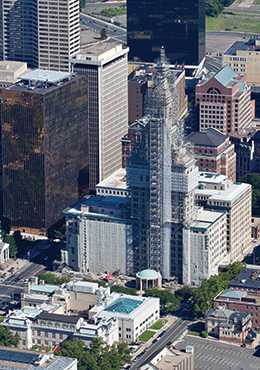 |
|
| At 527 feet, Safway Services erected the tallest, continuous Systems Scaffold in the United States for the renovation of the Travelers Tower, a 34-story building in the heart of Hartford, Conn. The irregular shape of the Tower made the project especially challenging. |
At 527 feet, Safway Services has erected the tallest, continuous Systems Scaffold structure in the United States. The work, now in progress through 2015, is part of a three-year building restoration project on the Travelers Tower, a 94-year-old landmark in the heart of Hartford, Conn. In addition, not only is the project the tallest, it’s one of the safest, with more than 40,251 man-hours worked without incident.
The project is taking place in phases. Phase one provided access to the ten stories of the base building. The base scaffold is 920 linear feet x 130 feet high with eight levels of planking, or 1.4 miles of working decks.
Phase two provided access to the 24-floor tower, which is technically an extension of two other buildings and begins after the 10th floor. The tower scaffolding is 348 linear feet x 527 feet high with a total of 72 work levels and 14 fully planked levels for 0.92 miles of working deck.
What makes the project and the height achievement especially remarkable is the 100 pounds per square foot (psf) load limit on the plaza in front of the building, which, by necessity, is the main staging area. Further, the terra cotta roof on the base building of Travelers Tower can hold only a 30-pound psf load – which is just enough to cover the snow load during winter – and it’s from this roof where scaffolding had to be erected on three sides of the tower.
Confronted with these limits, as well as the intricate ornamentation of the building exterior, Safway Services and restoration contractor Consigli Construction Co., Inc. (Milford, Mass.) worked together to carefully coordinate this feat of engineering – and did it all with minimal disruptions for the Travelers’ employees.
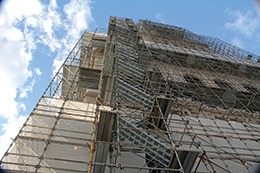 |
|
| Safway’s Systems Scaffold with lightweight aluminum decking and containment systems for increased safety encompassed the Travelers Tower |
“This is a monstrous engineering project, literally from before you begin engineering, to engineering the Systems Scaffold, to engineering the workflow. You have to plan for success,” says Justin Billings, Consigli project manager. Consigli is no stranger to restoring landmark structures. The construction company has worked on many landmark restoration projects throughout New England, and Hartford specifically, including the Wadsworth Atheneum Museum and Trinity College.
In 2012, The Travelers Cos. Inc. and their owner’s representative, CBRE, commissioned Consigli to begin the extensive project to restore the building’s exterior envelope. This included repairs to the granite veneer and masonry joints; replacement of multiple roofs on the tower and connected base building; replacement of all 2,000 windows; and refinishing the windows’ decorative wrought iron. The 34-story building, designed by American architect Donn Barber, was the seventh-tallest building in the world when it was constructed in 1919. Today, it is the second-largest building in downtown Hartford and stands stalwart in the city’s skyline.
Choosing lighter options
For a scaffolding project this large, the standard is to use double-base legs or heavy-duty legs for the extra weight capacity. However, double-sized legs are heavy. To accommodate the strict weight limits for the plaza and the roof, Safway executed some clever engineering to create a stable Systems Scaffold. Safway used lighter aluminum decking materials, fewer decks and reinforcements in the building’s columns, thereby allowing the use of single two-inch steel base legs.
“We worked with Safway to develop a compromise that maximized deck space and minimized weight,” says Mike Boucher, Consigli superintendent. For example, during phase one, Safway could put decks on eight levels and Consigli could work in three bays simultaneously (a bay is the space between vertical posts of a scaffold section). “We’re not doing heavy mason work. For the most part, it’s tuck-point repair, so we could go with a light-duty scaffold rating of 25 pounds psf.”
With the ability to work on eight decks in three bays, the project moved in corkscrew fashion down the building. Work began with masonry repairs on the westerly pink granite façade. By the end of the project, workers will have cut out and repointed mortar on more than 24 miles of mortar joints. To fix cracks in the stones, the architect reviews the severity of the cracks and recommends repinning the stones with stainless steel anchors or using epoxy injections and mortar to patch the cracks, so they’re no longer visible.
Next, repairs began on the cast iron around the windows. Painters stripped off the existing paint, and then another team repaired cracks or holes in the cast iron. Afterward, the painters returned and applied three sets of industrial coating from Tnemec Co. Inc. to protect the metal.
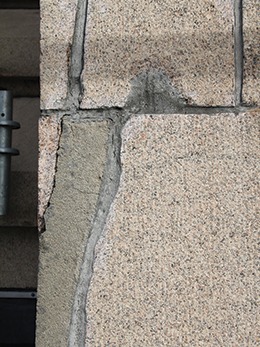 |
|
| Damage to the pink granite façade of the Travelers Tower required masonry repairs. Depending on the severity of the cracks, the stones were either repinned with stainless steel anchors, or epoxy injections and mortar were used to patch the cracks, so they were no longer visible. |
“We erected the scaffolding, then Consigli came in right behind us and performed their restoration work, and then our crew came in right behind them, dismantled that section of decking and moved it to the next area to keep the project on track,” says Stu Charlesworth, sales manager, Safway Group.
Boucher emphasizes, “Dates and deadlines are critical, because we have a linear schedule that impacts multiple trades. Until the decks are installed, we can’t put our masons on site, and the painter can’t work until the mason is done. We’re talking about 129,000 linear feet of masonry joints and 26,000 linear feet of caulking that had to be cut out and replaced with mortar. We constantly talked about dates.”
Currently, the project is ahead of schedule going into the 2013-2014 winter break, which is required because the mortar won’t set properly when cold.
Logistical puzzles and clever dunnage programs
The Travelers Tower project provided numerous access challenges, starting with the request to work without disrupting city traffic or building occupants. “From a logistics standpoint, we had to move materials in and out during non-work hours,” says Billings. “The delivery guys arrived at 4:30 a.m. and were gone by 6:30 a.m., so we weren’t clogging up the sidewalks and streets or bothering the public on their way into the building.”
That was the easy part. Working within space constraints and load limitations proved more challenging. Because the Travelers building occupies an entire city block, the only possible materials staging area was the 150-foot-wide X 350-foot-long plaza along the south side of the building, which only has a 100 pounds psf capacity. Further, after Safway engineers evaluated the plaza, they determined that an underground parking garage below the plaza would be vulnerable to collapse without shoring.
To reinforce the ceiling of the garage, Safway built and installed 200 concrete shoring posts and eight shoring towers along the entire south building line, which helped disburse the load from above. Because there were no drawings of what lay underneath the garage floor, Consigli employed a ground-penetrating radar company to help map out all electrical, plumbing and conduits to ensure no shoring posts were directly on top of them.
Next, Safway designed a dunnage program on the plaza for the scaffolding, common platform, materials and hoists. The weight of all materials, dumpsters and delivery trucks were scrutinized at all times to ensure the total weight stayed under the load limit.
“We scheduled more frequent, smaller deliveries during off-peak hours to accommodate the weight requirements,” says Billings.
No load but snow load
While the Systems Scaffold along the plaza could extend up to the 34th floor, access to the other three sides of the tower meant placing Systems Scaffold on the roof of the 10th story – a roof that could barely tolerate a snow load, much less the weight of scaffolding. To solve the problem, the scaffolding was tied into the steel columns of the building itself.
While Travelers provided Consigli with historic construction drawings, no “as-built” prints existed.
“We did a lot of exploratory work, pulling stone off the building to verify the steel was where the construction drawings said it was,” says Billings. “We cut holes in the roof to make sure beams and columns were where they were supposed to be. We needed to be sure we had the right loading capabilities. Putting something in the wrong place simply isn’t an option.”
After determining the location of the columns, Safway developed another dunnage program to carry the extended weight of the scaffold, plus all of the workers and materials. A custom-designed framework made from I-beams was tied perpendicularly and vertically into the main tower columns, and the scaffolding rests on them.
“The scaffolding sits directly on the building’s columns, so that we don’t have to put weight on the roof of the building,” says Charlesworth. “We built the scaffolding three feet above the roof and pushed all the loads directly back into the columns.”
Of course, getting the 14-inch web, 99 pounds per foot I-beams to the roof required more engineering feats: calculating the load for each outrigger of the Grove 275-ton crane, developing a plan to distribute the 46,000 pounds of steel on the roof during erection and completing it all over the weekend to minimize disruptions.
“We couldn’t just set up a crane, because it would have gone through the ceiling of the garage,” says Boucher. “We painted lines in the street to show where each outrigger had to be, where the crane had to be, and how far the operator had to swing and reach. We spent a lot of time planning.” As a result of that planning, Consigli was able to bring the crane into place at 4 a.m. on Saturday, make the first pick at 7:30 a.m. and complete all 63 picks by 3:30 p.m.
Additional resources
The Travelers Tower project required more than 89,486 Systems Scaffold components, the need to efficiently move decking to conform to work flow and, of course, moving restoration materials and the Consigli team.
To move men and materials more efficiently, experts from Safway Atlantic were brought in to erect a hoist capable of moving 6,000 pounds at 300 feet per minute. Safway Atlantic was created in 2011 by bringing together the experience and expertise of Atlantic Hoisting & Scaffolding and Safway Services to deliver comprehensive urban access solutions.
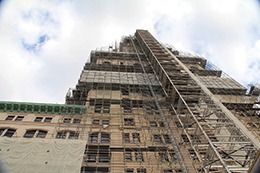 |
|
| Looking up from the 10th story of the Travelers Tower at the top 24 stories |
“Typically, it’s a challenge to get scaffold that high that quickly,” says Billings. “But the advantage of having the 6,000-pound hoist really helped improve our productivity.”
Drawing on another new resource, Safway employed HAKITEC 750 aluminum trusses to work around a peaked roof section which projects out from the tower. While newer to the United States, where Safway Group is the exclusive distributor, HAKI products have a long track record of global success.
“In Europe, we’ve been using HAKITEC 750 mm beams to span gaps for years,” says Charlesworth. “In this instance, we clamped two trusses together and used three sets of these trusses to span the roof peak and support the Systems Scaffolding.”
Safe by design
Despite the danger inherent while erecting the scaffolding, the Safway team has worked more than 40,251 man-hours without incident, due to a detailed, well-implemented safety plan that includes requirements for all erectors to be tied off with safety harnesses at all times.
“We showed our team that the work can be done productively while being tied off all the time in a safe manner,” says Safway Superintendant Russell Riopelle and Foreman Shawn Nedorostack. “We bought into the safety plan and executed it flawlessly. It’s really quite an achievement, to tell you the truth.”
To undertake a restoration project safely, on time and on budget, planning and team communication are essential.
“This is probably one of the largest scaffold projects ever undertaken in the New England area, and just by getting together, putting the right minds and the right people around the table, we have been executing a very safe and workable project,” says Boucher. “It’s a philosophy of ‘plan, communicate and execute.’ If you do those three things, you’ll knock it out of the park. And that’s what we’ve done.”
Safway Group companies offer multiservice solutions through experience in access, scaffolding, insulation, fireproofing, surface preparation and coatings. For more information, visit www.safway.com.
